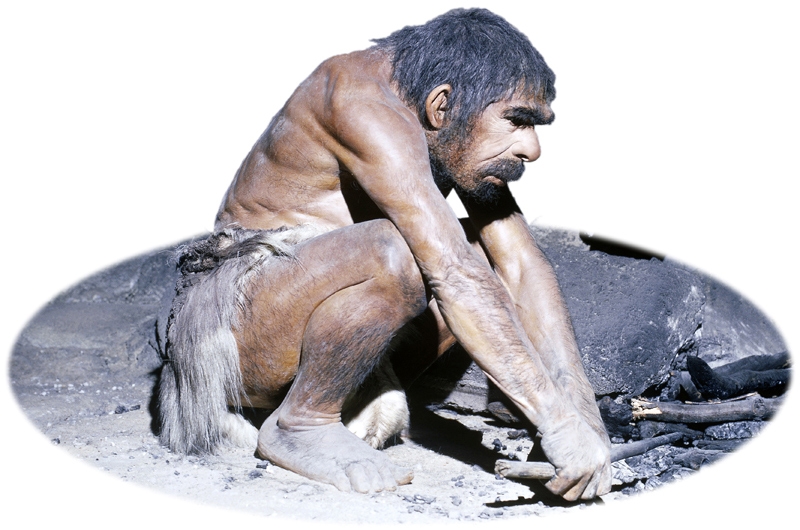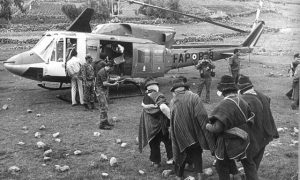The human species that today makes astounding advances in technology, and particularly in the medical field, did not exist four million years ago. In fact, hominids of that period were very different from the modern species in many ways. How did humans evolve to become today’s humans? How did Homo sapiens become so innovative? For one, they developed favorable qualities that were essential for adaptation and a thriving existence.

Homo sapiens derived from a form of early humans called Neanderthal. Unlike modern humans, characteristics of the Neanderthal included occipital buns and protruded brow ridges.1 One important facial feature of the Neanderthal was their large nose for “humidifying and warming cold, dry air” before it reached the lungs.2 Modern humans do not have this characteristic due to the fact that the Neanderthals lived in much harsher conditions. Thanks to the work of archaeologists and anthropologists, we know a great deal about the life and world of Neanderthals. The first fossils of these humans were found in France, and scholars have since called these humans Cro-Magnon. They created innovative tools from bones and antlers for hunting. This enabled them to survive and thrive in their environment. They even created artwork “in the form of decorated tools, beads, ivory carvings of humans and animals, clay figurines, musical instruments, and cave paintings.”3

Homo sapiens originated from East Africa. From there homo sapiens have migrated to all of earth’s main land masses. By taking advantage of land bridges, they have spread to Indonesia, New Guinea, Australia, and the Americas. Another contributing factor to the spreading of humans was the recent major Ice Age. The freezing of the oceans’ waters around the polar caps lowered the sea level, which exposed land bridges between land masses that were otherwise under water. For example, the connection between Calabria and Sicily had a sea level around -126 meters.4 They were able to adapt to the different environments due to their larger brain capacities, hence more intelligence. Having the knowledge that they had, they were able to create warm clothes and shelters to survive under various harsh conditions in the regions they occupied. Since they were nomadic people, there was no economic prosperity during the Paleolithic era. This was due to the fact that they never inhabited an area for a long duration of time. They were foragers; they scrapped up whatever they could find for survival, so there was no time period in which they could accumulate wealth. With that being said, that meant that there were no social classes. Instead, they lived an egalitarian lifestyle. While the men hunted, the women gathered. This method sustained their existence until the Neolithic Revolution, which domesticated both plants and animals.
The evolution of earlier hominids to Homo sapiens opened the door to a species capable of more advanced thinking about their surroundings and survival. The human race has since continued to thrive to the present. Without their innovative tools, body structures, and eventually domestication of plants and animals, Homo sapiens would not have been able to produce the advancements in technology and sciences that we have available today.
- Markus Bastir, Paul O’Higgins, and Antonio Rosas, “Facial Ontogeny in Neanderthals and Modern Humans,” Proceedings of the Royal Society B: Biological Sciences 274, no. 1614 (May 7, 2007): 1125–32. ↵
- Todd C. Rae, Thomas Koppe, and Chris B. Stringer, “The Neanderthal Face Is Not Cold Adapted,” Journal of Human Evolution 60, no. 2 (February 2011): 234–239. ↵
- “Evolution: Humans: Origins of Humankind.” Accessed September 10, 2016. http://www.pbs.org/wgbh/evolution/humans/humankind/o.html. ↵
- Fabrizio Antonioli, V. Lo Presti, M. G. Morticelli, M. A. Mannino, Kurt Lambeck, Luigi Ferranti, Catriona Bonfiglioli, et al., “The Land Bridge between Europe and Sicily over the Past 40 Kyrs: Timing of Emersion and Implications for the Migration of Homo Sapiens,” Rendiconti Online Societa Geologica Italiana, 2012. https://openresearch-repository.anu.edu.au/handle/1885/71477. ↵



99 comments
Natalie Childs
I really enjoyed this article. Before reading, I knew a decent amount due to a cultural anthropology class that I have taken, but it was really nice to read about it in such a well written article. The evolution of human beings is an incredible and fascinating study. From how different early humans were to how we are now, it really shows how much nature, and our bodies, are at adapting to our conditions.
Samuel Ruiz
As someone who does not take the side of human evolution, I found this article to be quite interesting. I like it because it told the details of how early humans were structured differently due to different environment conditions. It was also nice to learn about the origins of clothing, tools, and pieces of art in form of decorative stones and beads.
Hector Garcia
I have to say that it impressive to see all we have grown. From a simple Neanderthal to a civilization that is on the brink of colonizing Mars. It is incredible to read about our ancestors and read on how they were able to adapt to harsh environments. It’s amazing how Homo sapiens were able to develop larger brains that allowed us to create innovative tools that would forge our civilization. Overall, I liked the article because it was well-researched and showed a large amount of detail.
Kailan Pena
This was a great article that really highlighted the differences and adaptations of human beings. I found the info like on how noses even changed over time interesting. I didn’t really realize how much humans have changed over time or why they changed, so this article was very interesting and informative. I will say, what I found to be most interesting about this was that homo sapiens originated from Africa, I would’ve never known that if it weren’t for this article.
Nathan Hudson
I enjoyed reading this article. I particularly enjoyed the detail that you went into about the differences between the Neanderthals and Homo Sapiens. While it makes no sense to me, it was so interesting to read how their larger noses allowed for homeostasis in the lungs and body. It is weird to think that we are so new on this earth and there were so many things that came before us and through fossils we can determine so much about the history of civilization.
Tyler Thompson
This article was very well written, as it described how due to certain situations, these neanderthals had to adapt, in order to live. It was also interesting to see how their skulls differ from our’s too. The world os completely different now compared to then, especially as I read about how the sea level was way below what it is today, and how there were natural bridges connecting different countries.
Dayna Valdez
I really enjoyed reading this article. It’s always interesting learning about how humans have developed and progressed over time. How overtime, humans adapted to different things. The article was written very well and allowed me, as the reader, to imagine how characteristics could have possibly changed. The evolution of humans is crazy and I can only imagine how much more it could possibly change over time.
Troy Leonard
I like reading papers and articles bout how humans lived and survived back in the older ages. you did a great job on proving information and examples about the points you made. I thought it was kind of amusing when I read that they had big noses to warm the cold air before it reached their lungs. its really fascinating how the human body operates .
Tyler Sleeter
Very interesting article. I especially like the title of the article and at first thought it was about race and not species. I like timeline in your article as you trace the evolution of man to modern day humans. It is interesting to me that early man was able to use his environment to his advantage, adapting and altering objects to make tools for survival. It would seem to me that early man was much smarter then we often think. I have read lately that scientists have discovered Neanderthal DNA in modern man. I believe this means that at some point in our collective history Neanderthal and modern man not only lived at the same time but reproduced with one another.
Megan Barnett
Very informative article I find it a little funny though that Neanderthals had large noses “for “humidifying and warming cold, dry air” before it reached the lungs”. I guess since I don’t know much about how the human body works that I don’t understand how having a large nose helps in harsh conditions. You defined unusual terms very well including homo sapiens of course, egalitarian lifestyle, and a few others. You also did a good job of bringing back up the content about how homo sapiens were the start of our advanced society today in your conclusion.